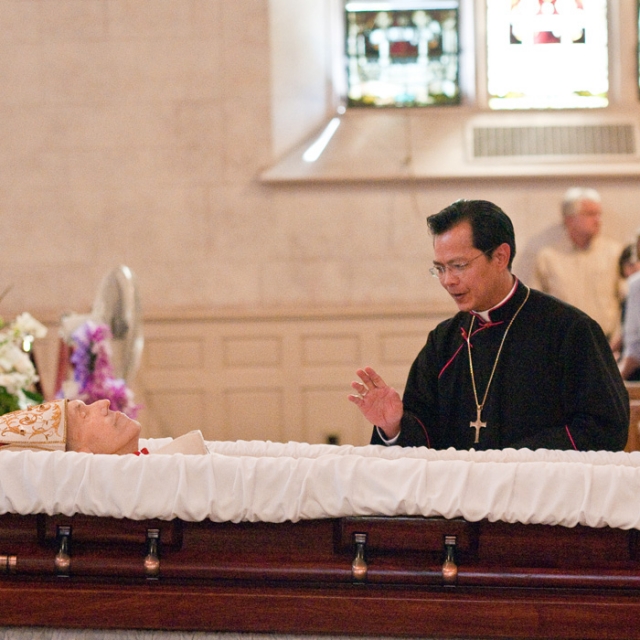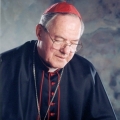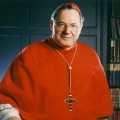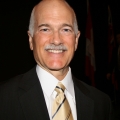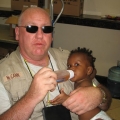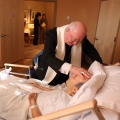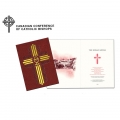TORONTO - They sang "Christ is the World's Light" as they wheeled Cardinal Aloysius Ambrozic's coffin down the centre aisle of St. Michael's Cathedral at 1:30 Tuesday afternoon to begin two days of vigil and visitation.
The cardinal's simple casket, adorned only with a crucifix, was greeted at the cathedral doors by St. Michael's Cathedral rector Fr. Michael Busch, who sprinkled it with holy water — a reminder of our common baptism.
The ceremony began with more than 200 already in the cathedral awaiting the cardinal's last entry into his Church. As the ceremony progressed they kept coming. By the time the congregation was singing Salve Regina the cathedral was more than half full.
Family, friends, trusted advisors and priests were among the first to file by the casket and offer a prayer for their old ally.
Friends recall Cardinal Ambrozic's dedication to Jesus
By Michael Swan, The Catholic RegisterTORONTO - Cardinal Aloysius Ambrozic spent 56 years as a priest because Jesus was the man he admired most. When he entered the seminary just after the Second World War the new seminarians were asked about their heroes. A few snickered when the immigrant boy from eastern Europe stood and named Jesus as his hero, but decades later as cardinal and archbishop he would stand at the pulpit and proclaim Jesus.
"It is Jesus to whom we look. It is Jesus whom we imitate. It is Jesus whom we follow. It is Jesus who is with us so we can be with Him," were words that often found their way into the late Cardinal Ambrozic's sermons.
"Any time he had a choice, his choice would be to talk about Jesus," said Kitty McGilly, former faith formation consultant with the Toronto Catholic District School Board. "He didn't say Christ, he didn't say God, he didn't say Lord. He very intimately named Jesus."
A friend of the cardinal's for more than 30 years, McGilly remembers him standing off-stage at the SkyDome in 1984 waiting to speak to 45,000 people who had turned up for an event called "Journey of Faith."
Knights of Columbus step up for Goderich tornado relief
By Vanessa Santilli-Raimondo, The Catholic RegisterTORONTO - The Knights of Columbus in the tornado-ravaged town of Goderich, Ont., are front and centre in the efforts to help the town recover from a devastating tornado that hit Aug. 21.
"(Our hall is) the evacuation centre," Steve Winter, Grand Knight of the Father Nagle Council 5420, told The Catholic Register. "We have a hall that will hold 600 people for banquets."
When the tornado tore through the town, "we were the spot in town that had electricity because we're hooked up to the town's generator," said Winter.
Because the Knights of Columbus hall is the central location for those in need, the Canadian Red Cross, the Salvation Army, Victims Services and the Society for the Prevention of Cruelty to Animals are set up in the hall, too.
Cardinal Aloysius Ambrozic — 1930-2011
By Catholic Register StaffTORONTO - As archbishop of Toronto for 16 years, Cardinal Aloysius Ambrozic oversaw the transformation of Canada's largest diocese into a multicultural, multi-racial home to 1.6 million Catholics. But while acknowledging the challenges implicit in change, Cardinal Ambrozic once said his main challenge was simply to be true to the Catholic Church.
That is how the cardinal is being remembered today, as a man unwavering in his beliefs and unfailingly true to the Church he served with faith, grace and distinction through 56 years of priesthood.
After a lengthy illness Cardinal Ambrozic died peacefully at Providence Healthcare Toronto on Aug. 26 shortly after receiving the sacramental anointing from Archbishop Thomas Collins, the cardinal's successor as archbishop. The cardinal was 81.
The body of Cardinal Ambrozic will arrive at St. Michael's Cathedral on Tuesday, August 30 at 1:30 p.m. At that time the Rite of Reception will be held.
His Eminence will lie in state for visitation at the cathedral Tuesday afternoon from 2-4 p.m. and 7-9 p.m. with the Office for the Dead being celebrated at 8:30p.m. All Tuesday events are open to the public.
The funeral Mass for Cardinal Ambrozic be held on Wednesday, August 31 at 10:30 a.m. at St. Michael's Cathedral. Due to renovations currently underway at the cathedral and expected articipation by up to 500 priests, family, friends, etc. There will be extremely limited public seating available.
In lieu of flowers, those who wish to pay tribute to the Cardinal are invited to donate to one of His Eminence's favourite charities, the Shepherds' Trust.
"Cardinal Ambrozic's tremendous contributions to the spiritual life of the faithful of our archdiocese and the heritage of his wisdom, his knowledge and his love of the priesthood will remain with us all," Collins said in a statement.
Collins praised Cardinal Ambrozic as a dedicated priest and brilliant scriptural scholar. He called him "a man who loved to learn, to teach and to spread the Gospel message in so many ways."
"Cardinal Ambrozic was a spiritual shepherd who cared deeply for all who were entrusted to his pastoral care, and we commend him in our prayers to our heavenly Father," Collins said.
Cardinal Ambrozic served as archbishop of Toronto from March 1990 until his retirement was accepted by Pope Benedict XVI and he stepped down in December 2006. He was named in 1976 by Pope Paul VI as auxiliary bishop to Archbishop Philip Pocock. His initial role included overseeing the expanding ethnic communities in the archdiocese. He was also a fervent advocate of Catholic education and had a particular interest in St. Augustine's Seminary, where he taught Scripture for several years and served as Dean of Studies from 1971 until his appointment as bishop.
On May 22, 1986, he was appointed coadjutor archbishop, meaning he had been selected to succeed Cardinal Gerald Emmett Carter on his retirement. On March 17, 1990, he was made archbishop. In 2002, Pope John Paul paid the cardinal a visit in Toronto, along with hundreds of thousands of young people who attended the World Youth Day in July of that year.  During Cardinal Ambrozic’s time, the face of the Church in Toronto changed dramatically. Fuelled by a flood of immigrants from countries around the world, it grew from a Catholic population of 1.1 million in 1986, when he was coadjutor archbishop, to more than 1.8 million today. To respond to the rising demand for spiritual nourishment and religious services, he oversaw the construction of 25 new churches, most in the rapidly expanding suburbs around the city.
During Cardinal Ambrozic’s time, the face of the Church in Toronto changed dramatically. Fuelled by a flood of immigrants from countries around the world, it grew from a Catholic population of 1.1 million in 1986, when he was coadjutor archbishop, to more than 1.8 million today. To respond to the rising demand for spiritual nourishment and religious services, he oversaw the construction of 25 new churches, most in the rapidly expanding suburbs around the city.
During his time as bishop and archbishop, lay movements and groups, many ethnically based, flourished and some of the ethnic (often called national) parishes became some of the most lively parishes in the diocese.
Cardinal Ambrozic was a private person who had a reserved personality that the secular media sometimes interpreted as aloofness. He was a fierce defender of the faith and was unafraid to combat cultural trends that threatened the underpinnings of family and Church. His views were often fiercely criticized in the media, which painted him as unwilling to yield to change. But in his position as one of Canada’s leading authority figures in the Church, he was unyielding in professing the truth of the Church and was undaunted by his critics.
He once attributed his durability to “simple natural stubbornness,” a clear sense of his own identity, daily prayer and “wonderful friendships with priests."
The priestly life that placed Cardinal Ambrozic at the top of Canada’s largest Catholic diocese began in a small, rural Eastern European settlement at a time when the Great Depression was ravaging most of the world.
He was born on Jan. 27, 1930 to Aloysius, Sr. and his wife, Helen, near Gaberje, Slovenia. The elder Ambrozic was a small farmer and grocer, an independent and outspoken man who took his religion as seriously as everyone did in those days in what was then Yugoslavia.
More than piety, however, Cardinal Ambrozic was shaped by his father’s sense of leadership, one that stemmed from the man’s abiding faith. He was the second of seven children, the eldest of five boys. As such, he felt an obligation to help the family survive in the leaner times in Slovenia that followed the Second World War.
The war brought strife, violence and destruction. It was a time of terror that made its mark on the future cardinal. His father, being an opinionated Christian Democrat, was hated by both the Communists and the fascist collaborators of Nazi Germany. Once the Nazis were defeated, the Communists won the peace in Yugoslavia, violently and systematically cleansing the country of all those who didn’t fit their plans.
In May 1945, the entire Ambrozic family fled to Austria. For the next three years, life was a series of displaced persons camps in Vetrinj, Peggez and Spittal an der Drau. Somehow the young man completed his high school education.
Canada beckoned, however, thanks to an uncle who was a Franciscan priest, a friendly bishop in Toronto and some Carmelite nuns. The sisters were asked to sponsor the Ambrozic family and readily accepted. On arrival in Canada, the elder Ambrozic got a caretaker job with a summer camp and the family moved to the spot near Markham, Ont.
Young Ambrozic, as the oldest son, fully expected his help would be needed to support the family. But it wasn’t necessary, so he began to consider his future. At the back of his mind was the priesthood.
“Certainly it wasn’t any kind of divine revelation. You go to the seminary because you want to try it out,” he once said. Though he originally saw himself as a scholarly priest, parish life began to grow on him. But he was called back to Toronto to teach Latin at St. Augustine’s. The official language of the Church is only one of four ancient languages he could speak.
Though he originally saw himself as a scholarly priest, parish life began to grow on him. But he was called back to Toronto to teach Latin at St. Augustine’s. The official language of the Church is only one of four ancient languages he could speak.
Then studies called. He was off to Rome for postgraduate work at the Angelicum, where he received a licentiate in theology, and the Pontifical Biblical Institute, where he obtained a licentiate in sacred Scripture.
While in Rome, he lived at the College Capranica, whose origins go back to the 15th century, the first residence for diocesan priests studying at Rome’s various universities.
Life in the birthplace of Europe in the 1950s was wonderful. When he wasn’t studying, there was a cozy coffee shop around the corner that “served the best coffee in Rome.” Then all around him was inspiration in the form of ancient churches and the ruins of the Roman Empire.
When his studies ended, Fr. Ambrozic returned to Toronto to teach Scripture at St. Augustine’s from 1960 to 1967. He would later teach New Testament from 1970 to 1976 at the Toronto School of Theology, which combines the religion faculties of numerous institutions, including St. Augustine’s. Besides teaching, he found time for academic writing, publishing The Hidden Kingdom: A Redaction-Critical Study of the References to the Kingdom of God in Mark’s Gospel (Washington, D.C., 1972) and Remarks on the Canadian Catechism (Toronto, 1974), along with other academic articles. In May 1976, Pope Paul VI called and Fr. Ambrozic became Bishop Ambrozic, auxiliary to Archbishop Pocock. Though it was an unexpected honour, he took to his new job dutifully and energetically. In 1984-85, he made pastoral visits to all 43 Catholic high schools in the archdiocese to strengthen and support religious education. He was also a member of the Christian Education Commission of the Canadian Conference of Catholic Bishops and helped revise the Canadian catechism.
In May 1976, Pope Paul VI called and Fr. Ambrozic became Bishop Ambrozic, auxiliary to Archbishop Pocock. Though it was an unexpected honour, he took to his new job dutifully and energetically. In 1984-85, he made pastoral visits to all 43 Catholic high schools in the archdiocese to strengthen and support religious education. He was also a member of the Christian Education Commission of the Canadian Conference of Catholic Bishops and helped revise the Canadian catechism.
Shortly after he was made archbishop of Toronto on March 17, 1990, he was one of four bishops chosen to represent Canada at the 1990 Synod on the Formation of Priests in Rome. More appointments quickly followed, including in 2005 when he was appointed to an advisory body on the financial matters of the Holy See.
Cardinal Ambrozic once said that, throughout his career, he never doubted that he answered the right call. “I went into it with a very clear idea of what I was into,” he once said. “I never felt I made a mistake.”
The Cardinal’s legacy is commemorated in several places throughout the GTA, including Cardinal Ambrozic Catholic Secondary School in Brampton as well as the Cardinal Ambrozic Houses of Providence, the long-term care facility in Scarborough, where the cardinal spent his final months.
{iarelatednews articleid="3397,299,3882,3810,292,170"}
Jack Layton's spiritual side revealed during battle with cancer
By Deborah Gyapong, Canadian Catholic NewsOTTAWA - Jack Layton was not religious but the former NDP leader is being remembered as a deeply spiritual man whose commitment to a caring society had a Christian foundation.
Changes coming in various dioceses
By Catholic Register StaffOTTAWA - Due to recent episcopal nominations as well as the death of Timmins Bishop Paul Marchand, a number of dioceses will see some changes in the near future.
Fr. Patrick Lafleur has been elected administrator of the diocese of Timmins after the death of Marchand, S.S.M., On July 24.
Dr. McCann cared for most vulnerable
By Michael Swan, The Catholic RegisterThere was never a time Dr. David McCann didn’t believe and never a time he didn’t know what he believed. Until he died Aug. 8 after a short battle with pancreatic cancer, the McMaster University associate professor of family medicine and expert in disaster relief operations only believed more and more — in God, his Church, his family and the inviolable sacredness of life.
The 50-year-old doctor leaves his wife Donna and five children.
He also leaves a sort of second family in the Florida One Disaster Medical Assistance Team. McCann was its chief medical officer despite having moved away from Georgia to Hamilton, Ont., in 2007.
A dual citizen, Dr. McCann had joined the emergency response team not long after working with survivors of the 9/11 terror attacks. He responded annually to hurricanes in the United States and to the 2010 earthquake in Haiti.
Hospice need is recognized, but little done to address it
By Luc Rinaldi, The Catholic RegisterTORONTO - For six years, the Toronto Commandery Foundation has been trying to find a site for a hospice that will allow terminally ill people to die with dignity.
But as the foundation has discovered, though everyone seems to agree on the need, no one wants to address it.
The foundation, a charity established with the co-operation of the Order of St. Lazarus, has spent its entire existence searching and negotiating for a site in North York to host a 10-bed end-of-life care facility. Though unsuccessful so far, there are no plans to stop looking any time soon.
“We’ve got all these oncologists saying we need a hospice, but there’s just nowhere for them to go,” said Jacqueline Wood, director of the foundation.
The Toronto Commandery Foundation was created out of this need, shared by a vast majority of Canadians. According to the Canadian Palliative Care Association, three-quarters of the 220,000 Canadians who die every year are in hospital or long-term care, while only 15 per cent have access to palliative or hospice care. On average, the cost of a bed in a hospice per day is $439, while a bed in a hospital or long-term care is nearly double.
A spiritual pilgrimage to help fight cancer
By Michael Swan, The Catholic RegisterTORONTO - It’s 805 kilometres from St. Jean Pied du Port in the French Pyrenees to the Cathedral of Santiago de Compostela and 72-year-old George Xuereb believes he can walk it without getting blisters.
He has reason to be hopeful. He’s already beaten prostate cancer, so anything is possible.
Xuereb will walk the Camino de Santiago de Compostela — the Way of St. James — with his son Michael, who harbours doubts on the blister count. Michael Xuereb walked the Camino last year and lost track of the number of blisters that emerged on his feet. He remembers precisely the number of toenails he lost — six.
“I figure if I lose five toenails or less I’m moving in the right direction,” said Michael.
CWL vows to tackle destruction of embryos
By Luc Rinaldi, The Catholic RegisterTORONTO - Toronto hosted 620 delegates of the Catholic Women’s League from Aug. 14 to 17 as they gathered for the 91st annual CWL National Convention, themed “Centred on Faith & Justice.”
The four-day conference, held at the Toronto Marriott Downtown Eaton Centre Hotel, presented four new resolutions that will be initiatives of the League in the coming year. The resolutions include prohibiting practices involving the destruction or manipulation of human embryos, providing support for children of missing and murdered aboriginal women, creating a national organ and tissue donation and transplantation registry, and mandating caffeine warning labels on energy drinks.
The resolutions were chosen from a group of more than a dozen proposals that had risen through the diocesan and provincial councils to the national level from parishes across the country.
CCCB to launch web site for new missal
By Catholic Register StaffOTTAWA - A new web site for the Canadian edition of the Roman Missal will help Catholics across Canada to understand the contents of the new book.
The web site can be found at www.romanmissal.ca.
Available this fall, the web site includes resources for preparing parish bulletins and workshops. It also has links to Roman Missal-related materials from the National Liturgy Office and the Publications Service of the Canadian Conference of Catholic Bishops, who will be producing the missal.
Also, parishioners can access the web sites of Catholic dioceses across Canada concerning the Roman Missal as well as links from the Vatican and English-speaking conferences of bishops around the world.

